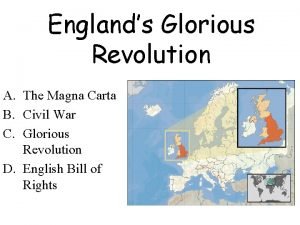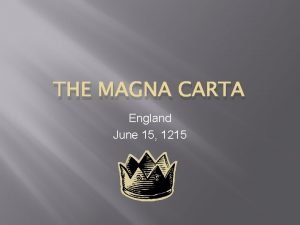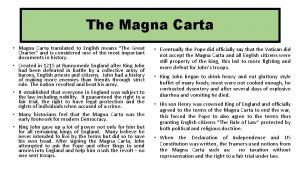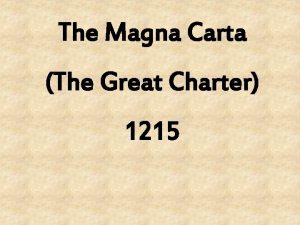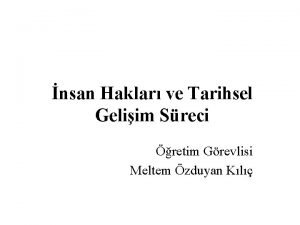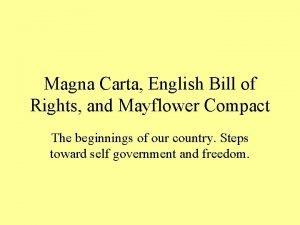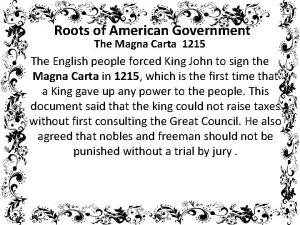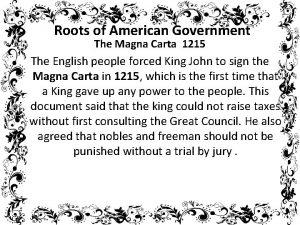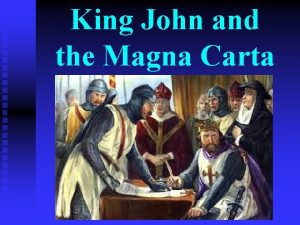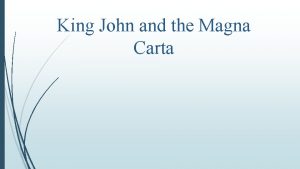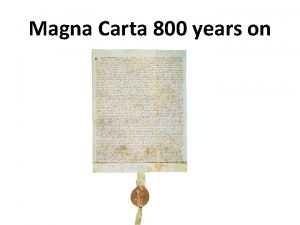Roots of Revolution Magna Carta 1215 King John









- Slides: 9

Roots of Revolution

Magna Carta (1215) King John (1199 -1216) of England was forced by nobles to sign the Magna Carta “Great Charter” • Established the principle of limited government. – The King’s power was limited NOT absolute. • King had to obey laws like everyone else

Key Ideas from the Magna Carta • Established English Common Law ~ a system of law based on precedent set in previous rulings. – Precedent – ruling by a court on a similar case • Established Habeas Corpus – Can not be imprisoned without a trial • Established Due Process of Law – Formal legal proceedings (conviction, trial, sentence, jury decision, etc. ) • Established idea of No Taxation without Representation

Virginia House of Burgesses (1619) • Founded in 1607, Jamestown was started based on a royal charter ~ a written document granting land authority to set up colonial governments • Virginia House of Burgesses (1619) ~ first representative assembly in colonial America – Legislature – makes laws (example: Congress) – Established a bicameral (2 house) structure. • Virginia was divided into 4 districts with 2 delegates each. – Only white, male, property owners were allowed to vote.

Mayflower Compact (1620) • Before landing at Plymouth Rock, 41 pilgrims aboard the Mayflower signed this document outlining rules for government • Mayflower Compact (1620) ~ was the first direct democracy in colonial America. – Direct Democracy = allowed all adult men to vote on issues by popular vote or majority rule • Under this government pilgrims elected their own leaders and created their own laws.

Fundamental Orders of Connecticut (1639) • Fundamental Orders of Connecticut (1639) ~ the first state constitution. – Constitution = a written set of laws about the government • Key Ideas in the Fundamental Orders: – Limited the power of the government – Contained majority rule, consent of the governed, and protected minority rights. • Copied by all other colonies!!

Religious Freedom • Colony of Rhode Island (1644) ~ established by Roger Williams who was banished from Massachusetts. – Established the idea of separation of church and state. • Maryland Toleration Act (1649) ~ Guaranteed religious freedom to all Christians. • William Penn’s “Holy Experiment” (1681) ~ established the colony of Pennsylvania for Quakers. – Considered the most democratic colony.

English Bill of Rights (1689) William III In 1688, Parliament invited William and Mary to take throne of England from James II, Mary’s father this was called the Glorious Revolution. Mary II • Parliament demonstrated that it was stronger than the king. • English Bill of Rights (1689) ~ severely limited the power of the monarch; Parliament and English citizens were given far more power and influence • Significantly influenced the American Bill of Rights!

Key Ideas from the English Bill of Rights • Extended the Rights guaranteed in the Magna Carta. – Kings do not have the divine right to rule – Kings rule due to the consent of Parliament (and voice of the people) – People have the right to petition the government – People have a right to a speedy and fair trial – People have a right to a jury of their peers – people have a right to be protected from cruel and unusual punishment. – People have a right not to be charged excessive bails and fines.
